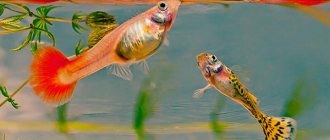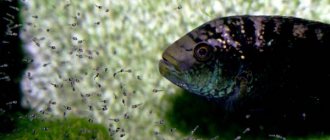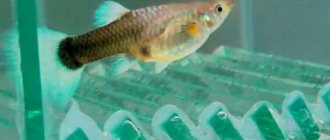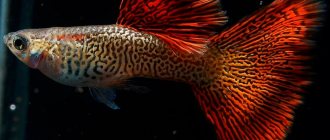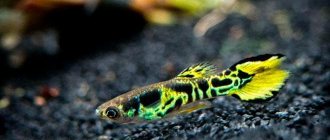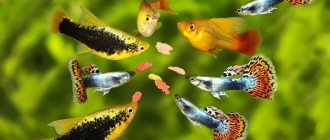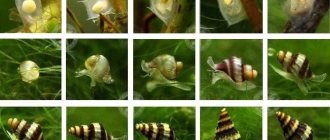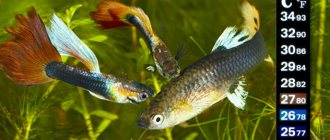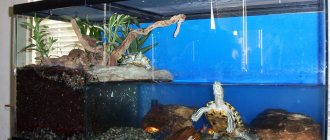Diversity in the world of viviparous fish
Guppies are a species of aquarium fish that have gained widespread recognition. They are bred by both beginning aquarists and experienced specialists. In such a matter, it is important to know the nuances, for example, to understand what temperature should be in the aquarium for guppies, how many times and what to feed these fish, whether they need an aeration system, etc. It is worth saying that guppies attract the attention of aquarists for many reasons:
- These tiny fish are easy to keep. A beginner can handle them. Many people start them without having heaters, because the temperature in a guppy aquarium can be close to room temperature.
- Being viviparous individuals, they will not construct special islands for spawning. They also do not need to be placed in a separate aquarium during spawning.
- A huge number of colors in the color of the scales and caudal fins makes guppies attractive to aquarists.
- Watching the hectic life of a small flock of guppies in your own aquarium is the highest pleasure for a true esthete.
- Guppies are kind of aquarium cleaners. Beginners are often advised to have them, because in an unsettled and not completely neglected aquarium, various unwanted inhabitants, such as white glass worms or nematodes, can appear. So, guppies can easily save an inexperienced aquarist from such a misfortune by simply eating unnecessary animals.
Diseases of ornamental fish
Usually neither sellers in pet stores nor breeders want to blame themselves for the death of fish. Everyone is guilty of illness. If the guppy died gradually, and not in an instant, then it really is a disease. There are various medicines for ornamental species, but before you buy them, you need to be sure of the diagnosis.
We recommend reading
About the luminous fish zebrafish glofish
Now about what diseases are usually found in guppies.
Dermatomycosis (saprolegniosis) - the disease appears if the fish has been in cold water for a long time. The infection spreads very quickly. The first sign is the appearance of a coating on the scales in the form of moss and white threads. What to do if guppies die in an aquarium from ringworm? This issue requires an urgent solution. Infected fish must be isolated immediately. The fungus can be removed with bicillin.
Gyrodactylosis - a whitish-blue coating appears on the guppy, the eyes become cloudy, and the fins shrink. The causative agent of this disease is the parasite Gyrodactylus. A sick pet must be placed in a container with a special solution: 1.5 mg of copper sulfate per liter of water. Without fish, the parasites will die on their own within a week. The aquarium for fry must be treated with table salt.
Ideal aquarium temperature for guppies
If we judge the survival threshold, then guppies are able to exist in conditions from 15 to 36 degrees Celsius. But for them this is rather an extreme temperature, so these indicators should not be adhered to. Otherwise, you can significantly shorten the life of the fish by killing them with neglect. Experts recommend setting the temperature within 23-27 degrees. In general, ideally the temperature in a guppy aquarium should be 24 degrees Celsius, but a slight deviation of a couple of degrees down or up will not cause significant harm to the health of the pets. By the way, the rather wide temperature range of keeping guppies in an aquarium is another reason that these fish are the most popular in pet stores. You can safely add them to more heat-loving fish or to cold-loving ones.
Experts recommend, if necessary, increasing or decreasing the temperature in the guppy aquarium on a gradual basis. A sharp drop can harm the health of the fish. During spawning, the temperature can be slightly increased, because at first the fry need more gentle conditions for proper and rapid development than mature adults.
Incorrect water temperature or dirty filter
The optimal climate is from 20 to 25 degrees. It should not be allowed to cool down to 18 degrees; in cool water, guppies’ immunity weakens and they can get sick. High temperature (from 26 degrees) is also undesirable. Pets live less in it. For example, at a temperature of 22 degrees, a guppy will live for two years, and at 28 - only one.
In warm water, bacteria multiply faster, and there is less oxygen, but more toxic substances. To prevent the water from overheating in the summer, there are special fans that lower the temperature by a couple of degrees. It is very good if the room has air conditioning. In winter it is enough to simply ventilate.
Bacteria form on the cleaning system. Such microorganisms are always present in water, but an imbalance (an increase in the number of microbes) leads to illness and death of the fish. It is necessary to clean and change the filter promptly.
Content
In addition to the question discussed above about what the water temperature should be for guppies in an aquarium, there are a number of other rules for their successful maintenance. When it comes to proper nutrition, experts advise alternating dry food and frozen food; both options can be found without problems in pet stores. Guppies love daphnia, coretra and cyclops. The fish will not refuse bloodworms either. Experts recommend sprinkling a pinch of food once a day, maybe twice, but little by little. Fish should not be overfed. In addition, the quality of the feed plays a crucial role. If you buy it for a month at once, then it is better to freeze the “live” food. Obviously, the questions about what temperature is needed in the aquarium for guppies and what to feed the fish are the main ones in the content, but there are other important nuances.
Why do fish suddenly die and what should be done?
A change in appearance is the first sign indicating the poor condition of the inhabitants of the aquarium. The reasons why guppies die in an aquarium can be different.
Poor quality or dirty water is the main problem leading to the death of pets.
The following water requirements must be observed:
- acidity (pH) should be from 6.5 to 7.5 (there are special drop tests to change this indicator);
- oxidability - from 2 to 6 mg of oxygen per liter of water (depending on the amount of food eaten and excrement);
- hardness from 8 to 15;
- nitrites - no more than 100 mg per liter.
Fish contribute to the accumulation of ammonia, so it is necessary to monitor its level. You need to remove 1/5 of the volume from the aquarium once a week and add fresh water. You should never completely change the fluid. This is a lot of stress for the fish.
Fill the aquarium with settled water. If you need to change it urgently, but there is no prepared liquid, then you can artificially clean it of unnecessary impurities. To do this, add 5 drops of sodium thiosulfate to 35 liters of tap water (you can buy it at a pharmacy).
Facts about caring for fry
Sooner or later the guppies will give birth. When this happens, you should take care of the young animals. It is better to separate the fry from the adults. For these purposes, a container of 20 liters may be quite suitable. But there is another acceptable option: divide the aquarium with a fine mesh net. This way the fry will be able to penetrate through her holes, swimming away from the mother, who can eat them. The optimal temperature in the aquarium for young guppies is no different from that recommended for adults. Of course, for the first days of life it is better to maintain a temperature of 27 degrees Celsius, gradually reducing it to 24.
Why does a male guppy chase a female?
At the age of 4 months, the fish begin to reproduce. No special conditions are required for this. The water temperature should be above 18 degrees, as guppies do not mate in cold conditions. The gestation period lasts 30-35 days. Before mating, males begin to chase females. If there are many males, the female may die. During pregnancy, it is also undesirable to change the living conditions.
We recommend reading
Types of sturgeon fish
It is necessary to take into account the compatibility of breeds: temperament and habits. Carnivorous fish cannot coexist with herbivorous fish in the same aquarium.
The number of males and females should be proportional. For example, if males die, it means there are many females in the aquarium, and the male representatives are fighting because of competition. Optimal option: up to three females per male. The aquarium should have vegetation or other shelters so that if conflict situations arise, the guppies have somewhere to hide.
Changing water in an aquarium with fry
Experienced aquarists recommend changing up to 40% of the water every day in an aquarium with young guppies. Under normal conditions of life, when all the fish are mature and strong, this procedure is carried out once a week or as the aquarium becomes dirty. In all cases, the water being poured must be settled and have a temperature as close as possible to the temperature in the guppy fish aquarium to avoid unnecessary stress for the pets. The filter sponge must be washed as needed if its model is installed inside an aquarium. If an external modification is used, then the cleaning procedure will be carried out quite rarely (sometimes once every six months). As for the aeration of water in a guppy aquarium, it will never be superfluous, because additional saturation of tap water with oxygen is a big step towards the health and longevity of the fish.
As you can see, keeping guppies is not at all difficult. It is only important to choose the right conditions for them, and then the natural corner in the house will delight and bring aesthetic pleasure.
Lack of oxygen in the water and too much feeding
If the guppies die one after another, you should make sure there is enough oxygen in the water. A compressor must be running in the aquarium. As the water temperature rises, the amount of oxygen decreases. This situation can occur at night when the compressor is turned off. Plants also do not produce oxygen in the dark, so it is better to keep the compressor running around the clock.
We recommend reading
Varieties of algae eaters in the aquarium
Pets can also die due to too frequent and abundant feeding. This is especially true among beginner aquarists who have not understood the nuances.
Guppies should not be overfed; the food that remains begins to decompose, releasing toxic substances.
Because of the waste, the water becomes cloudy, the biobalance is disrupted, and the fish die. If you notice that the liquid has begun to lose transparency, clean the bottom of the aquarium and the filter.
